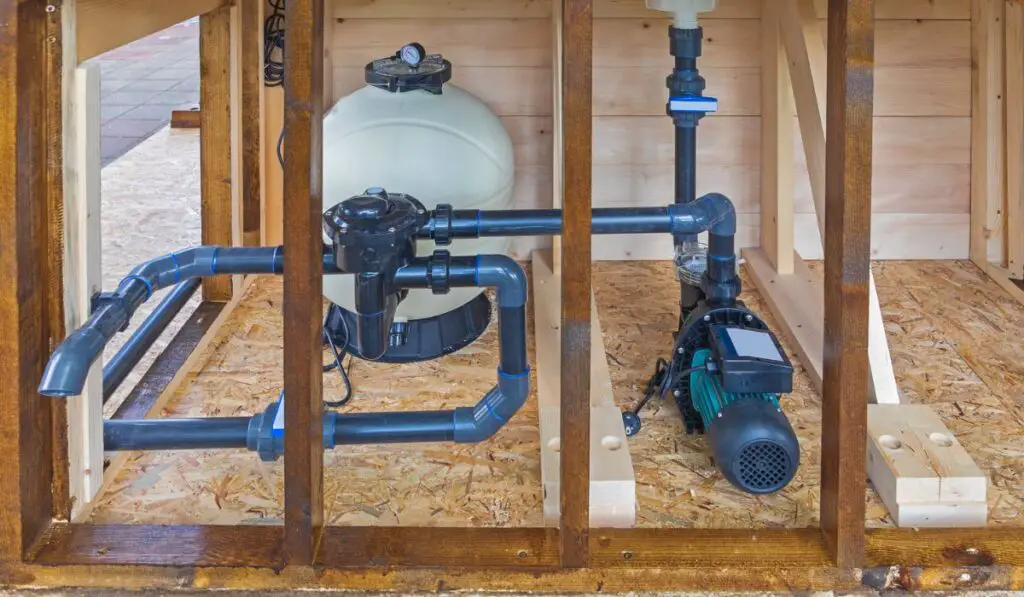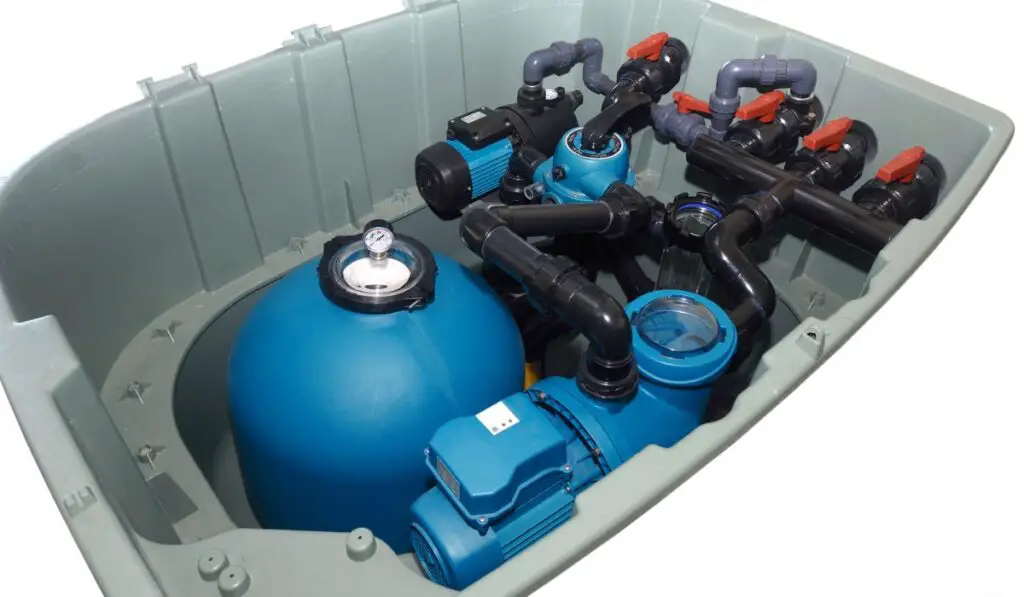Whether you’re filling up a brand new pool or reopening your current one after winter, you’ll inevitably have to deal with air in the pump and lines. Air can also enter the lines after you’ve made repairs to the pool equipment or replaced the filter or pump. So, what should you do to remove air from your pool pump?
To “prime” a pump, you need to remove air from all the pump and all plumbing. Start by putting all the valves in normal operating positions and letting water flow into them naturally. Turn the pump on, and if bubbles from the jets stop within a minute or so, you’re good to go.
Air pockets in your pump or pool can cause damage to your pool equipment. Fortunately, this problem has a very easy fix, and you’ll be able to dive into your pool again in no time. Let’s look at the reasons behind the air pockets, how you can remove air from your pool pump, what equipment you’ll need, and when you should contact a professional for help.
How Do You Get Air Out of Your Pool Pump?

In order to remove air from your pool pump, you first need to close all the line valves. Then, turn on the pump and slowly open the line valves to introduce air into the pool pump until it sucks out all the air.
Here’s a more detailed guide you can follow to get the air out of your pool pump:
- Switch off the pump and other functioning pool equipment: The first step is to temporarily turn off all pool equipment, including the pool heater and pump.
- Prime the pump: It’s important to make sure that your pump is primed. Open its lid and check if it has water. If the pump is empty, fill it with water.
- Check o-rings and pump lid: The pump lid is notorious for causing air pockets in pool lines. If the lid is damaged or cracked, air will inevitably enter the pump. So, make sure you replace damaged lids as soon as possible.
It’s also important to ensure that the o-rings inside the covers are in perfect condition. If these o-rings are dry, loose, or cracked, they will allow air to enter the pump system. If you notice dry o-rings, try lubricating them with o-ring lubricant. - Twist the multiport valve to the filter position: DE and sand filters are usually designed with multiport valves. These valves have several different functions, like backwashing, but they also help remove air from the pump and pool lines.
Twist the valve to the filter position before moving on to the next step. - Turn on the pool pump and slowly twist open the valves: If you’ve recently repaired your pool equipment or opened your pool after winter, the valves in the filter system might be closed. If you fully open these valves and turn on the pump, air will enter the pump, damaging it and causing it to lose its prime.
For this reason, it’s important that you first switch on the pump and then open the valves very slowly. It’s also advisable to start with the main drain and then move on to the other valves.
Don’t worry if the pump makes a bit of noise as it removes the air from the lines. Once the pump starts filling up with water, open the main valve a bit further, but make sure you proceed as slowly as before.
Keep turning the valve slowly until it’s fully open and there’s no air left in the pump. Repeat this step for all pool valves. - Remove air from the pool filter: There should be one or two air pressure release valves on the housing or canister of your pool. With the pool pump running, open the valves, and close them once the water starts flowing out. This should take around 20 to 40 seconds.
- Check the filter pressure gauges: After removing the air from the pump and pool lines, check the filter pressure level. A pressure level of 10-25 psi or 50-75 Kpa indicates that there’s no air in the pump or pool lines.
Why You May Need to Remove the Air From Your Pool Pump
Air inside your pool pump is a serious problem that can cause irreparable damage if left unaddressed. Keep in mind that every pool’s filtration system will release a few bubbles from the return jet, particularly during the initial pump start-up and shortly thereafter.
If you see bubbles only for a few minutes after you turn on the pump, there’s no need for concern. The real problem occurs when the return jet continually releases bubbles, and the pump’s trap fills with air instead of water.
Air inside the pump can result in poor filtration, which can eventually lead to cloudy water and algae. Low water levels inside the pump can also result in a burnt-out or overheated motor.
While the first issue (bubbles in the return stream) is an annoyance, the second one spells complete disaster and might cause serious problems that will require the expertise of a pool professional.
Equipment You Need for Pool Pump Air Removal
You don’t need a lot of tools to remove air from your pump. You can easily get the job done with an o-ring lubricant (on Amazon).
However, there are a few other pool cleaning tools that can help you maintain your swimming pool, including but not limited to:
Corner and Step Vacuum Brush
A step and corner brush like this one from Aquatix (on Amazon) is extremely useful and can clean areas that a typical vacuum simply cannot reach.
Leaf Net
If there are a lot of leaves at the bottom of your swimming pool, then a good leaf net will be a godsend. Try to purchase a unit that’s easy to use and able to get under the leaves easily, like this professional leaf net from LALAPOOL (on Amazon).
Robotic Pool Cleaner
Robotic pool cleaners are a bit expensive, but they’ll definitely give you your money’s worth. It’s advisable to opt for a quality model that, along with the bottom of the pool, will also clean the sides and the waterline, like the DOLPHIN Nautilus CC Supreme (on Amazon).
Why Is There Air in My Pool Lines?

Having air inside your pool lines is not necessarily a problem. In fact, it’s perfectly normal to have air pockets in your pool lines if you’ve reopened the pool after winter, completed some maintenance work on the pool’s system, or are using a new pool.
This is because air will enter the lines as soon as you open all the valves. If this is the case, you just need to prime the pool pump and then remove the air from the pool lines.
However, if you still notice air in the lines (even after bleeding it out), then there is something else causing the problem. Here are a few reasons why there’s air in your pool lines:
Low Water Level
If the water level in your pool is below the skimmer, the pool pump will start sucking in air instead of water through the skimmer. To fix this problem, you just need to fill up your pool so that the water level is halfway or more than halfway up the skimmer box.
Loose or Damaged Pump Lid
A loose, damaged, or cracked pump lid will result in air getting into the pool lines. Even a small crack in the lid threads or the lid will allow air to enter the system.
If you notice that your pump lid is damaged or cracked, replace it as soon as possible.
Defective Seals or O-Rings
Your pool has several seals and o-rings. If these seals are defective or damaged in any way, air will get into your pool lines.
Make sure you check the seal on your pool pump lid regularly, as they wear out fairly quickly. If you see any cracks or notice that the seal has lost its shape, replace it immediately.
It’s also advisable to use seal lubricant when installing the pump lid seal to protect it and enhance its durability.
Damaged Pool Lines
While cracked pipes are not usually the reason behind air in your pool lines, they are still susceptible to damage. They can crack or break because of tree roots or age.
Accidentally putting a pickaxe or spade through the pipes while gardening can also cause severe damage.
Loose Pool Pipe Unions
All pipe connections, or pipe unions, are possible sources of air pockets in the pool lines. In fact, a pipe joint is extremely susceptible to damage, which is why it’s one of the most common causes of air leaks in pool lines.
For this reason, it’s important to make sure that all unions are correctly and tightly sealed.
Is It Normal for Bubbles to Come Out of Your Pool Jets?
Sometimes, you might notice bubbles coming out of your pool jets. This is perfectly normal while you’re bleeding the pool lines, as the air being sucked out of the pump has to be released somewhere.
However, if you notice bubbles coming out of the return jets after you’ve completed the bleeding process, then you might have a serious problem.
When to Call a Professional
If you’ve tried removing the air from the pool lines and pump yourself, but the problem still persists, then it’s better to call a professional who can properly diagnose and repair the problem.
You should also call a professional if you think that the air is entering through the cracked lines between the pump and the skimmer. This problem can only be checked by performing a pressurization test — something that’s best left to a professional pool service company.
